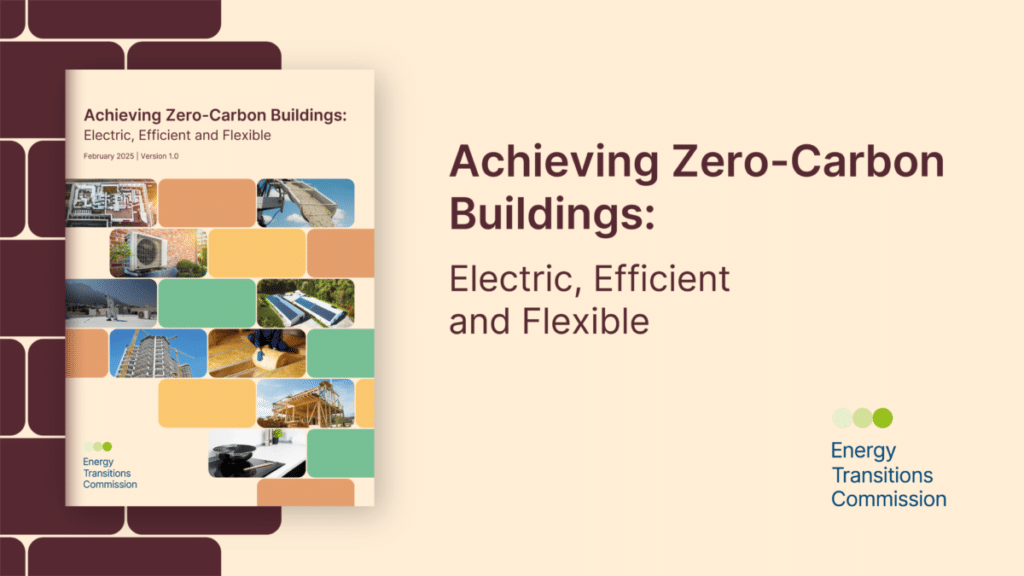The latest report from the Energy Transitions Commission, Achieving Zero-Carbon Buildings: Electric, Efficient and Flexible, draws a complete picture of the buildings sector’s emissions and energy use and describes how a combination of electric, efficient and flexible solutions can decarbonise buildings, improve standards of living, and reduce energy bills if supported by ambitious policy.
The global buildings sector currently contributes a third of greenhouse gas emissions (12.3 GtCO2 in 2022).1 This comes from the use of fossil fuels for heating, cooling, cooking, lighting, powering appliances, and constructing residential and commercial buildings.
There is not a one-size-fits-all solution for decarbonisation, as different solutions work for different building types, countries, and climates, but three key priorities stand out for creating a zero-carbon dioxide emissions buildings sector:
- Electrification replacing fossil fuels: Decarbonising heating and cooking is essential. Currently, gas and oil heating accounts for 8% of global emissions, or 3 GtCO2. Switching from fossil-based heating and cooking to cost-effective electric and efficient technologies, such as heat pumps and electric hobs, is crucial and must be accompanied by the continued decarbonisation of electricity generation. By 2050, 80% of the energy used in buildings could be electricity; this would bring annual emissions from building use close to zero if electricity supply is decarbonised by then.
- Dramatically improving energy efficiency: Rising use of air conditioners and the electrification of heating and cooking would result in electricity demand for buildings almost tripling, from 12,800 TWh to around 35,000 TWh by 2050 if energy efficiency is not simultaneously increased. But this could be reduced to around 18,500 TWh via a combination of:
- Improvements in the technical efficiency of heat pumps, air conditioners, and other appliances.
- Improvements in the energy efficiency of both new and existing buildings, considering a range of so-called “passive heating and cooling” building design techniques, such as insulation and painting roofs white in hot countries.
- Smart building management systems and consumer choices which avoid wasteful use of heating or cooling.
These improvements, together with the deployment of building-level batteries and other energy storage, smart building control systems, and rooftop solar generation are particularly important for reducing the growth of peak electricity demand, which is a crucial driver of electricity system costs.
- Constructing efficient and low-carbon buildings: Constructing new buildings accounts for 7% of global emissions a year, or 2.5 GtCO2. Global floor area (area covered by buildings) is set to expand by 55% by 2050 (or 140 billion m2, which is almost 150 times the size of Hong Kong), predominantly in Asia, Africa and South America. If the average carbon intensity of construction remains unchanged, this expansion would result in a cumulative 75 GtCO2 emissions between now and 2050.2 These cumulative emissions could be reduced to around 30 GtCO2 via a combination of:
- Decarbonising the production of steel, cement, concrete, and other building materials.
- Using fewer materials in building construction via lightweight design and modular construction or using less carbon-intensive materials such as timber.
- Better utilising existing buildings via extended building lifetimes and shared working spaces.
“Decarbonising the buildings sector is a story of many transitions. It’s vital for our climate goals and it’s an opportunity to improve living standards and reduce energy costs. Electric heating and cooking technologies will significantly improve air quality and have lower running costs than gas heating and traditional use of biomass. Cooling is essential to quality of life, especially as global warming intensifies due to man-made emissions. It is possible to achieve zero-emissions, efficient, and flexible homes with low-carbon building design techniques and technology that runs on clean electricity.” said Adair Turner, Chair of the Energy Transitions Commission.
However, implementing some of the decarbonisation options for buildings poses more complex challenges than faced in other sectors of the economy, for instance:
- For existing buildings, residential and commercial building owners can choose from many different low-carbon technologies and options to improve the energy efficiency of their homes, some of which can be disruptive and involve high upfront costs (e.g., roof or wall insulation, new windows, higher-efficiency heating and ventilation systems). The availability and cost of finance vary greatly between low and high-income households and across countries. Government policies must therefore combine clear targets to ban the sale of fossil-fuel boilers and cookers, with financial support for low-income families, as well as external finance (e.g., from multilateral development banks) to lower-income countries.
- For new construction, specific optimal solutions vary by country, regional climate, and building type, and there are sometimes trade-offs to be struck between designing to minimise construction emissions versus in-use operational emissions. In addition, construction sectors often entail complex value chains of subcontracting and a large role for small and medium enterprises. Careful design and implementation of building design and construction codes, learning from international experience but tailored to specific circumstances is therefore vital.
“Unless we can radically decarbonise buildings we will fail to keep global warming under 1.5°C outlined in the Paris Accord. To do that we need to make changes all the way through the design, delivery and operation of buildings – from electrification of heating and passive cooling, to reducing embodied carbon emissions for new buildings and refurbishments.” said Stephen Hill, Sustainability and Building Performance Expert at Arup. “This will require collaboration right across sector, between governments, industry bodies and private companies. We need to be ambitious, but if we get it right we can cut carbon, generate value for our economy and improve people’s quality of life through action like improving living conditions and reducing fuel poverty.”
























































